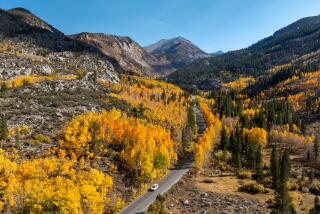Superbloom starting? In Lake Elsinore’s poppy fields, definitely
Little Lake Elsinore southeast of L.A. has shifted into superbloom mode. Blankets of orange poppies cover the hills in Walker Canyon, causing traffic on Interstate 15 to back up almost 20 miles at times. “Those hills are just covered with millions of poppies,” said Kim Cousins, president of the Lake Elsinore Chamber of Commerce. “It’s on, as they say.”
By the way, superbloom isn’t a scientific term, it just indicates a wildflower season that “exceeds typical spring blooms,” according to National Geographic. In California’s deserts and canyons, the right combination of rain and favorable temperatures (without raking winds or bloom-busting heat) at the right time determines how spectacular the season will be.
But predicting when and where is difficult.
“One area can get a complete deluge and a half mile away can be really dry,” said Madena Asbell, director of plant conservation programs at the Mojave Desert Land Trust in the town of Joshua Tree. “That plays the biggest role in whether you’re going to see a big bloom and where the flowers are.”
Right now, that would be Lake Elsinore.
California golden poppies have popped, and have been drawing about 1,000 people each day to have their photos taken in the sea of orange. Cousins estimates the big show will be on for about another week. Two years ago, the area was equally inundated during a poppy superbloom.
To get there, exit Lake Street off Interstate 15 and turn onto Walker Canyon Road. Stay on the trail to avoid trampling flowers, obey parking signs and make sure vehicles are fully off the road, and dispose of all trash properly.
Here are other SoCal locations where wildflowers are starting to put on a show.
►Joshua Tree National Park: Dense stands of purple lupine are blooming on the desert floor and up to the road near the southern entrance of the park about 160 miles east of downtown Los Angeles.
Right now you can expect to see tall purple blooms with light yellow desert dandelions and golden poppies mixed in. “I would say it’s probably peaking this week,” said Asbell, who visited recently.
Take a hike on the Bajada Nature Trail to get closer to the flowers. To get there, take exit 168 for Cottonwood Springs Road off the 10 Freeway and drive north into the park.
►Anza-Borrego Desert State Park: The highest superbloom hopes have been pinned on California’s largest state park located in San Diego, Riverside and Imperial counties. Right now, pygmy golden poppies carpet the desert near what’s called the Texas Dip, a wide dip in the road between Borrego Springs and Ocotillo Wells.
Other areas are starting to pop too. “You’re seeing sections of heavily carpeted areas,” said Brianna Fordem, interim executive director at the Anza-Borrego Foundation. “Things are only getting better. If conditions stay the way they are, we’re in for it to be really beautiful.”
The most popular wildflower field in the park is located along Henderson Canyon Road, between DiGiorgio Road and S-22. It’s not totally blooming yet, but when it does, yellow sunflowers, dune evening primrose, white desert lilies and purple sand verbena will draw visitors and photographers. Here’s a park map detailing where flowers are blooming now.
►Diamond Valley Lake: The lake’s wildflower trail opened last Saturday in the southwest Riverside County reserve. Golden poppies and other wildflowers are starting to bloom, but peak isn’t expected until mid-March. If conditions hold, they may last through April. The trail is open Wednesdays through Thursdays. It costs $10 to park and $3 per person for hikers. To get there, take Highway 79 to Domenigoni Parkway and Angler Avenue.
More to Read
Sign up for The Wild
We’ll help you find the best places to hike, bike and run, as well as the perfect silent spots for meditation and yoga.
You may occasionally receive promotional content from the Los Angeles Times.







